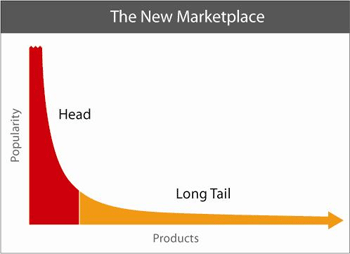Sunday, July 30, 2006
Away For A While
Friday, July 28, 2006
Mickey's Birthday Party Part 3
Muse is better known for his work on the Tom and Jerry series, but he made an impression on somebody at Disney who talked to film critic Frank Nugent. In 1947, Nugent wrote an article called "That Million-Dollar Mouse" for the N.Y. Times Magazine. It's reprinted in the book Walt Disney Conversations edited by Kathy Merlock Jackson. In the article, Nugent writes, "Artists like Fred Moore, Marvin Woodward, Les Clark and Kenny Muse have helped [Mickey] to express himself." This was half a dozen years after Muse left, but his name still came up in connection with the Mouse.
Muse only gets three scenes here, but the third one is just plain stunning. Muse was a very strong draftsman and as wild as Mickey's action is, the drawing stays controlled. Mickey is appealing in every drawing.
Thanks to Galen Fott, you can click here and see a rough drawing of Mickey dancing by Ken Muse. Note the difference in costume. That led to some confusion as to whether the drawing came from Mickey's Surprise Party (a 1939 World's Fair industrial Disney did for Nabisco) or Mickey's Birthday Party. We've determined that the drawing doesn't appear in the industrial, so my guess is that Muse animated the scene before somebody decided to change Mickey's outfit. Some poor assistant animator got stuck making the change.
Director Riley Thomson follows Muse to wrap up Mickey's dance and in my opinion is even better. Thomson is more willing to push his timing accents, uses a stronger line of action and is generally more willing to distort Mickey for effect. I can imagine Thomson directing this cartoon and deciding the scene was too juicy to give away, so he kept it for himself.
This cartoon is heavily cast by character, and Bernie Wolf gets Donald. Wolf was an important animator in the '30's, working for Fleischer, Iwerks and Disney. He was in the First Motion Picture Unit during the war and later worked for Hanna Barbera and Film Roman, though I have no idea what he was doing in the period between the war and his TV years.

Scene 28 starts out with some solo dancing by Donald, and Wolf is willing to push his poses for the musical beats as much as Les Clark. What's really interesting is that for scenes 36.2 and 36.4, Clark and Wolf each take a character in the scene. 36.4, in particular, has a lot of character interaction. Donald rides on Clara's rear and she bounces him against the wall several times. I'm guessing that Clark had to go first, with Wolf working to Clark's drawings. When the interaction really gets wild in scenes 40 and 40.1, it was impractical for two animators to handle it, so Clark did it all.
This is the third Mickey cartoon directed by Thomson that's been discussed here. They're great cartoons and every one of them contains great animation. It's clear that Thomson valued that, being an animator himself, and he really gave his crew opportunities to shine.
Thursday, July 27, 2006
Mickey's Birthday Party Part 2
It seems that every one of these shorts reveals another "unknown" animator. Marvin Woodward animates an awful lot of this cartoon and does a great job. His Mickey and Minnie are very appealing and solidly drawn. His work is not as flamboyant as some other animators' scenes in this cartoon, but Woodward gets all the Mickey and Minnie acting scenes. The characters are likeable and you can really feel the relationship between them.
According to Alberto Becattini, Woodward started at Disney around 1931. He's got work in Snow White and the Seven Dwarfs, Pinocchio, Fantasia, The Three Caballeros, Ichabod and Mr. Toad, Cinderella, Alice in Wonderland, Peter Pan and Lady and the Tramp, but what scenes did he do? I can't think of any, yet he was clearly a very capable animator.
The mysterious Shafer (who is probably Milt Schaffer, but not definitely) handles most of the Goofy scenes with James Moore picking up the rest. These scenes could easily come out of a two-reel comedy as they're close to slapstick sitcom. The animators manage to make the cake gags believable, even though they're fairly cartoony and Goofy is an appealing victim of his own ineptitude.
My admiration for Les Clark continues to rise. Here, he gets away with some risque breast gags with Clara Cluck and Donald. I'm surprised that the Hays office let this get through, considering how skittish they were about udders just a few years before.

When Clara is dancing, there are some extreme visual accents used for a single frame to really hit the musical beat. Take a look at this drawing. Her rear, breasts and shoulder are all pushed uncomfortably, but because it's for a single frame it doesn't bother you at normal speed. Clark does all of Clara's dancing scenes and they're full of this kind of distortion to match the musical beat.
I'd have to know more about Clark's feature work, but I wonder if he might not have had more freedom on the shorts. It doesn't seem that he was often the lead on a feature character, so he was forced to make his work fit in with other people's. Maybe that watered it down. On the shorts, Clark's characters exude confidence and liveliness. Were those qualities present in his feature work?
Can somebody define what the Music Room was? My understanding is that it was where the directors and the composers worked out the timing and score of the cartoon, but why are the first scene (which is just a background) and 4.1 (Minnie putting on lipstick) credited to the Music Room? Were there artists and animators assigned to it?
I'll talk about Ken Muse, Riley Thomson and Bernie Wolf in a future entry.
Tuesday, July 25, 2006
Mickey's Birthday Party
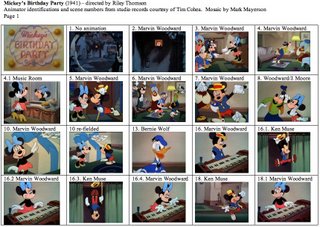
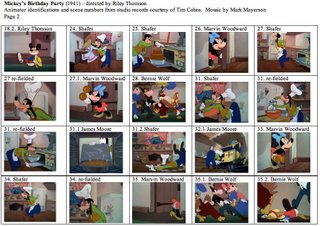
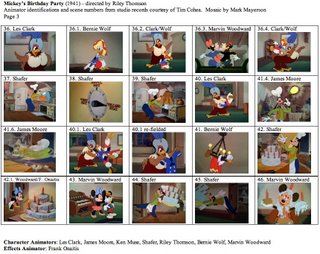 Here's a mystery that I hope someone can solve. The animator draft lists Shafer, but there was nobody at Disney that I'm aware of whose last name was spelled that way. There was Armin Schafer and Milt Schaffer, both of whom animated at Disney in the 1930's, but Albert Becattini doesn't list either of them animating into the 1940's. Did either of them work on this cartoon, or is it somebody else?
Here's a mystery that I hope someone can solve. The animator draft lists Shafer, but there was nobody at Disney that I'm aware of whose last name was spelled that way. There was Armin Schafer and Milt Schaffer, both of whom animated at Disney in the 1930's, but Albert Becattini doesn't list either of them animating into the 1940's. Did either of them work on this cartoon, or is it somebody else?I'll write more about this film in a future entry.
Monday, July 24, 2006
The Long Tail
Before mechanical reproduction, all culture was local. Culture couldn't travel unless a human carried it and humans could only travel as fast as an animal could carry them.
The 19th century was an explosion of technology and mechanical reproduction. The telegraph annihilated distance. A message could cross the continent instantly, instead of having to be carried by railroad. Improved printing technologies, phonographs and movies enabled the creation of mass culture. By the early 20th century, when they were joined by radio, these technologies allowed people over a wide geographical area to be reading, listening and seeing the same cultural products.
The problem with this model was the cost of production and distribution. If you made a movie, you needed the equipment to photograph and edit it. Beyond that, you need a lab to develop and print copies of your film and an organization that could carry the copies to theaters over a wide geographical area. All those things took money, which meant that once the mass culture industries were established, it was difficult for a newcomer to compete with them. The cost of starting such an enterprise was prohibitive.
Because of the high cost of production and distribution, the culture manufacturers had to appeal to the widest possible audience in order to turn a profit. They needed hits. They couldn't afford to alienate any part of the audience (one reason for the adoption of the Hays censorship code) and they often stuffed something for everyone into a movie whether it fit or not. This is why MGM Marx Brothers comedies have romantic couples, songs and in The Big Store, a fashion show.
TV followed the same model, especially in the years before cable.
At the retail level, where books and records were sold, stores were physically limited by shelf space. Given the choice of an item that would sell 10 copies a year or 20, the proprietor naturally gravitated to the 20 copy item as it generated more cash from the same amount of shelf space. Items that didn't sell sufficient copies weren't stocked. They were invisible to consumers.
With the internet and other technological advances, everything has changed. Production and distribution costs have come down, especially for items that can be created with software and then downloaded. Retailers who sell over the internet are no longer restricted by needing space in a high traffic neighborhood or by the size of the local population. The result is the long tail.
In a nutshell, the long tail says sales of niche items add up to a significant portion of revenue. Physical limitations (space, number of outlets, etc.) used to truncate the tail, but now it just keeps on going. Where 20% of the merchandise used to result in 80% of the revenue, the proportion is no longer nearly so lopsided.
You're in the long tail while you're reading this. No question that this blog is a niche item. Rather than read or watch Harry Potter, you're here. And because you're limited by the number of hours in your day, the time you spend here and in other niches can only take time away from the hit properties. There will still be hits, but Anderson thinks that in the future they will be smaller due to competition from niche items.
What are the repercussions? If you're a consumer (and aren't we all?), you've got much greater choice than before. Rather than settle for the books or the DVD's in your local shop, you've got a vastly larger choice available to you online. If you're a creator, there are two possible repercussions. If you're working in a company that depends on hits, you may find that budgets will be squeezed if audiences don't turn out in the same numbers that they used to. If you're an independent creator, you've got an easier time reaching an audience that is increasingly seeking out specialized material that's more satisfying to them than the mainstream.
However, the long tail isn't utopia. Sellers will have a much easier time taking advantage of it than creators. If storage space is cheap, sellers can afford to carry an item that might only sell once a year. But a creator can't live on something that only sells one copy a year.
There are lots of creators who do things for the pleasure of it without financial compensation. This blog is an example. For those people, reaching an audience is its own reward though it may possibly lead to paying gigs of various sorts. For animation creators who are looking for the work to pay their way, the business model is still evolving. I've already pointed to Keith Lango's essay on this and he has some good points. I've got some ideas that I'll be tossing out here eventually.
Regardless of your goals, The Long Tail is a book that will help clarify the world you're living in. Anderson's insights are worth reading and as they describe changes to the consumer culture, they are relevant to everybody.
Saturday, July 22, 2006
Web Auteurs
The article hits many of points that have been raised here. Some quotes:
(I know that I've been concentrating heavily on the industry here, lately. I'm going to be reviewing The Long Tail in the next day or two and then I promise to get back to another mosaic and some animation history.)Some people say that the film industry has more to fear than just being late to the party. If the Net begins spawning films — and not simply helping to market or deliver them, as has happened to date — studios’ grip on the business of putting pictures on screens may be challenged.
“Their nightmare is a direct feed from moviemaker to audience,” said Walter Kirn, a frequent contributor to The New York Times who has been serializing his novel “The Unbinding” on www.slate.com and saw one of his other novels, “Thumbsucker,” adapted to the big screen. “Their only trump cards are that they are pools of capital for making expensive things. Otherwise they are cut out of the action.”
Geoffrey Gilmore, director of the Sundance Film Festival, said: “We are probably at a period of greater change than we have had in the past 50 years. The industry is scared about what they should make and how they should deliver it. What’s the next step? Where’s the development coming from?”
Of course what makes the Web attractive is that there are no gatekeepers — managers, agents, studio executives, or film-festival programmers — to get past. But that’s also what makes finding truly satisfying entertainment difficult. On YouTube alone tens of thousands of videos are posted every day.
Mr. Kirn predicted that “all of the zoo animals are going to get out.” He continued, “The question is whether they will be paid,” because the Net so far has offered virtually unlimited freedom but very limited rewards.
Friday, July 21, 2006
We Don't Get No Respect
His Disney chapter is chock full of errors that could easily have been fixed. His bibliography lists Hollywood Cartoons by Barrier, Disney Animation: The Illusion of Life by Thomas and Johnston, The Art of Walt Disney by Finch and The Art of Animation by Bob Thomas, so how is it that basic errors have crept into the text?
Winsor McCay is misspelled. Max Fleischer is erroneously credited for Felix the Cat. The Three Little Pigs was released in 1933, not 1932. Alice in Wonderland was released in 1951, not 1957. Carl Stalling was a composer, not an animator. It's Carl Eduarde, not Edwards. It's Grim, not Jim, Natwick. It's Tytla, not Tytler. It's Ted Sears, not Wears.
Besides the factual sloppiness, there is uncritical research. Anything in print must be true. Johnson's description of the Disney strike is as follows.
As he employed a good many intellectuals, artists, and writers who at that period leaned overwhelmingly toward the left, this produced tension at the Disney Studios and, in 1940, led to a strike aimed either at forcing Disney to make pro-Communist propaganda cartoons or at shutting the studio down. Disney defeated the strike, with some help from J. Edgar Hoover's FBI, and pursued his own individual way until his death.Johnson's source for this is Marc Elliot's Walt Disney: Hollywood's Dark Prince. It's a bad source and the quote above is demonstrably false on several counts. Disney lost the strike as the company had to recognize the union. The strike was about issues like wages and had nothing to do with the content of the films. Nobody, including the strikers, wanted the studio shut down.
In the introduction, Johnson says that, "Walt Disney needed to wash his hands, sometimes thirty times in an hour." That isn't sourced, but can anybody really take that seriously? How could he run the company unless he carried around a portable sink?
I'm tired of authors who have made their reputations elsewhere thinking they're qualified to write about animation. And I'm tired of mainstream publishers like HarperCollins simply accepting whatever they're handed because of the author's reputation. If Johnson made this many mistakes in his chapters on Chaucer, Shakespeare, Austen, Eliot, Hugo or Dickens, you can be sure that an editor would catch them. But, hey, it's only animation.
Thursday, July 20, 2006
A Bunch of Links
Steve Schnier is the creator of the animated series Freaky Stories as well as a producer on series like Magic School Bus and a writer on Atomic Betty. Steve has never been shy about thinking outside the box. He's currently working on a feature made from found footage and he's blogging about it here.
On July 11, I mentioned two articles by Keith Lango on the economics of independent animation. He's added parts 3 and 4 and both are worth reading. Keith is also answering questions about his approach to animation on the cg-character forum.
IDT continues their retreat from the animation business. They're selling their 62% of Mainframe in Vancouver to Rainmaker. Details here.
Wednesday, July 19, 2006
Digital Downloading
Now, Scott Kirsner is reporting that CinemaNow is immediately offering burnable DVD versions of 100 older movies such as Scent of a Woman, Barbershop and Charlie's Angels: Full Throttle. The L.A. Times (registration required) says that
Studio executives hope that as more titles become available online, Internet services will emerge as a way for movie fans to buy niche or older films that can be difficult to find at mass-market retailers. Some retailers that sell on the Web are considering starting their own online movie services.Prices will be between $9 and $15.
While things seem to be speeding up, The Hollywood Reporter says that the studios are afraid of cannibalizing existing DVD income streams like Wal-Mart. The big box retailers together account for 60% of North American sales. Hollywood doesn't want to do anything to damage that income until they're sure that downloading will compensate for any big box losses, which is why that CinemaNow is being given older films. Those won't damage sales on the new releases at Wal-Mart.
On another front, Classic Media has hired Andrew Perlman as VP of digital media. His job is to make Classic Media's properties, which include Casper, Rocky and Bullwinkle, Mr. Magoo, Underdog, Roger Ramjet, Little Lulu and Veggie Tales, available for cell phones and online.
I don't think that this is going to kill the DVD market. Downloading probably won't include extras and once DVD's go to a hi-def format, downloading and burning will take longer, assuming that the consumer has the ability to burn hi-def DVD's.
However, this is another potential market for any independent filmmaker and, as I said earlier, a way to sell films without the expense of manufacturing and distributing DVD's. Just put your trailer on YouTube, Google and Yahoo with a final title card directing people to the website where they can buy the complete burnable download.
Tuesday, July 18, 2006
The Talent Differential
I've worked at and visited a lot of studios since then and I've discovered that every studio contains a lot of talent and that the talent in a studio is always greater than what reaches the screen. I call this the talent differential.
Good studios are the ones with the narrowest gap between their staff's talents and what's on screen. Bad studios have the largest gaps.
The size of the gap is usually determined by the company management. To my thinking, there are four types of management.
Hands-on management with tasteUsing historical examples, Disney was an example of hands-on management with taste. Walt Disney drove his studio in a particular direction that set standards that we're still striving to match.
Hands-on management without taste
Hands-off management with taste
Hands-off management without taste
Famous Studios was an example of hand-on management without taste. By the late 1940's, there was a real cookie-cutter look to their cartoons, regardless of who wrote them or directed them. There's no question that the staff's talents didn't reach the screen, as many of the same staff had worked on the Fleischer features.
Leon Schlesinger was the hands-off management with taste. Chuck Jones seemed to have a real gripe against Schlesinger, but Schlesinger had a sterling track record. The directors he hired and kept included Friz Freleng, Tex Avery, Bob Clampett, Chuck Jones, and Frank Tashlin. The directors he got rid of included Tom Palmer, Bernard Brown, Jack King, Ben Hardaway, and Cal Dalton. Once Schlesinger had a director he was happy with, he left the director alone, which is why the Warner directors showed so much individuality.
Some people are going to disagree with me on this one, but I think Walter Lantz was a hands-off manager with no taste. Yes, he hired Shamus Culhane, Dick Lundy, Tex Avery, Jack Hannah and Sid Marcus, but he let Culhane go and he seemed satisfied with Alex Lovy and Paul Smith. The last 16 years of the studio's existence was pretty bleak as a result.
Perhaps the most interesting thing about this is that successful management is not limited to people with art backgrounds. Schlesinger outshines other studios run by artists. Ultimately, it's about taste: recognizing the talent you've got and knowing how to manage it for the best result on the screen.
iTunes Movie Rentals
Monday, July 17, 2006
Borge Ring's Oh My Darling
This film predates Anna and Bella, but there are many strong similarities. Once again, Ring concentrates on family dynamics. Instead of siblings, this film is about the relationship between parents and children. And again, Ring uses visual metaphors to find animated ways of expressing things. Birds are one of the key metaphors here, to suggest empy nest syndrome and the creation of new romantic couples. As in Anna and Bella, there are ambivalent relationships, though in this film they don't quite get worked out.
I'm utterly amazed that Ring hasn't been more influential in terms of his design style, his subject matter and his direction. His films are just gems.
Movielink To Make Downloads Burnable
Sonic Solutions software will be used to prevent users from duplicating the DVD.
If this works, it will spread to other companies. Because on-line rentals are not restricted by physical inventory limitations, I don't doubt that companies will host independent films. If you can manage to finance a feature of some type, you can not only earn rental dollars from Movielink but also generate DVD sales without the hassles of manufacturing and distribution.
Time will tell if this has an impact on DVD retailers like Wal-Mart.
Sunday, July 16, 2006
Kimball's Cricket
 I'd like to point everybody to Larry T's blog, where he has posted 41 drawings from a Ward Kimball Jiminy Cricket scene from Pinocchio. In addition to the drawings, he has videos of the drawings and a clip of the finished piece. Larry includes an example of a scene folder and discusses the typical animation pipeline of the time.
I'd like to point everybody to Larry T's blog, where he has posted 41 drawings from a Ward Kimball Jiminy Cricket scene from Pinocchio. In addition to the drawings, he has videos of the drawings and a clip of the finished piece. Larry includes an example of a scene folder and discusses the typical animation pipeline of the time.Kimball's work always has a strong line of action and a clear silhouette. There's a simplicity to his drawings that's not easy to achieve. He has a real gift for making a clear, direct statement in every drawing while never losing the appeal of the character design.
There's a wealth of information in the drawings Larry posted. In the sample above, we can see that Kimball is calling for a trace back of Jiminy's left foot. There's also got a spacing chart indicating how the inbetweens should be drawn. There are production, sequence and scene numbers stamped on the drawings so that the drawings can't be misplaced if they get separated from their scene folder. And we can see the reinforcement put on the center peg hole to keep the registration steady for camera. Every one of those things is useful for animation students to know. Some of them, with a little thought, are as valuable in cgi as they are in drawn animation.
This is also an example of Disney's five hole peg system. I was under the impression that the center hole and the outer horizontal holes were used by the animators, leaving the other two holes fresh for the inking stage. Does anybody know if that's the case?
When you're finished looking at Larry's blog, you can see some more of Kimball's Cricket drawings in this segment from the Disney Family Album. Kimball explains how Jiminy's design evolved and around 3 minutes in, Kimball flips a scene of Jiminy.
Friday, July 14, 2006
A Scanner Darkly
There's also some interview footage with the people behind the film on the same webpage.
The Brave Little Tailor Part 4
In Burt Gillett's case, we have a pretty good idea. At Disney, Gillett directed some fairly notable cartoons: Flowers and Trees, The Three Little Pigs, Mickey's Gala Premier, Playful Pluto, Lonesome Ghosts and The Brave Little Tailor. Walt Disney obviously had faith in him or he wouldn't have assigned him such important cartoons.
Other studios were interested in Gillett because The Three Little Pigs was one of the most successful short cartoons ever made. The Van Beuren studio hired Gillett to upgrade their films. While today we have a fascination with the quirkiness of the Van Beuren cartoons from the early '30's, at the time the studio was stuck with a silent cartoon drawing style and unable to create popular characters.
Gillett converted the studio to color production, upgraded the drawing and bought rights to characters like Felix the Cat and Toonerville Folks. The studio created original characters like Molly Moo Cow. If you've seen these cartoons, they're far slicker than Van Beuren's earlier films but they still lack strong stories and characters. When Disney made a deal to distribute through RKO, RKO dropped the Van Beuren cartoons and the studio closed.
Gillett returned to Disney for a couple of years but left again in 1938 when he moved to the Walter Lantz studio. He worked on the first few Andy Panda cartoons and a couple of fairy tale spoofs, but his cartoons at Lantz resemble his Van Beuren work far more than they do his work at Disney.
While Gillett was present at the birth of personality animation at Disney, I don't think that he really understood it. The ghosts in Lonesome Ghosts are interchangeable in a way that the three pigs are not. The giant in The Brave Little Tailor is thinly conceived; he's not as interesting as the big bad wolf. With the possible exception of Andy Panda, Gillett wasn't involved with a successful character outside Disney, and Andy was stolen from Fannie Brice's radio character Baby Snooks.
In his biography The Walter Lantz Story, Joe Adamson quotes Lantz saying, "Burt had to do things over and over and over again. He was a trial-and-error person....Gillett never knew where he was going." It took Disney and his story department to give Gillett something to run with. Away from Disney, he couldn't manage it himself.
Gillett left the animation business in 1940 but lived until 1971, dying at the age of 80. I have no idea what he did after leaving animation, but I'd be curious to find out.
Thursday, July 13, 2006
Different Kinds of Creativity
Cartoonist's Work Banned By Prison!
No, he was drawing pretty girls.
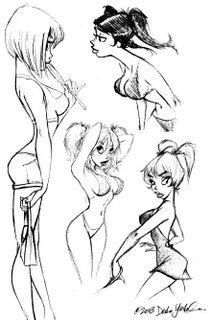 Nancy Beiman wrote me that our mutual friend, Dean Yeagle, received a letter from the North Carolina Division of Prisons banning his sketchbooks because they were too risqué. You can read Dean's reaction to this on Nancy's blog. I can think of many things that are threats to the social order, but Dean Yeagle sure isn't one of them.
Nancy Beiman wrote me that our mutual friend, Dean Yeagle, received a letter from the North Carolina Division of Prisons banning his sketchbooks because they were too risqué. You can read Dean's reaction to this on Nancy's blog. I can think of many things that are threats to the social order, but Dean Yeagle sure isn't one of them.Dean will be appearing at Comicon International in San Diego on a panel with Stephen Silver and Glen McIntosh called "Designing Appealing Characters." If you're a convicted felon from North Carolina and plan to attend, don't tell your parole officer.
Wednesday, July 12, 2006
The Brave Little Tailor Part 3
As in Mr. Duck Steps Out and The Little Whirlwind, Clark gets the entrance of the main character. I'm sure that he earned those opportunities through the quality of his work. The scene of Mickey swatting the flies contains some lovely, subtle distortions of Mickey's head and hands when he first goes after the bugs.
Moore has a couple of scenes and scene 45 is the best, with some nice acting. Mickey has to put on a brave face for Minnie, but his real feelings come out as soon as he turns away from her. It's interesting to see how Moore's Mickey is shorter and squatter than Frank Thomas's.
Ollie Johnston gets the montage sequence after Mickey swats the flies. It's more action than acting, but it's vigorously animated and the drawings are solidly proportioned even when the characters are moving in perspective. Ollie also gets a couple of Mickey scenes. 73A looks like it was added as an afterthought to focus the audience on Mickey pulling out his needle. There's a continuity error on the width of the thread between this scene and the Roy Williams scenes that bookend it.
Riley Thomson's king has a wonderful fleshiness to his jowls and great follow through on his robes. While Frank Thomas takes over the king once Mickey arrives, I think that I like Riley Thomson's version better. It has a greater presence. Thomson also gets some scenes of Mickey; there's good acting in scene 48 and a great scramble exit in 49A.
Don Patterson seems to get the short end of the stick in this cartoon, getting stuck with crowd scenes and long shots. He went on to do great animation at MGM, but it looks like the Disney studio didn't trust him with big scenes at this point.
Roy Williams does the scenes of Mickey inside the giant's mouth. That's imagery worthy of the Fleischer cartoons of the early '30's and it's helped along by excellent effects animation by Cornett Wood.
This is the last Disney cartoon directed by Burt Gillet to be released. I want to talk about him in a future entry.
Tuesday, July 11, 2006
Making Money From Your Films
In any case, there's been some very good discussions on other sites about the economics of posting films to the various video web sites such as YouTube and its competitors.
I'd like to point you to two entries at Cartoonbrew.com, this one and this one. I suspect that everybody who reads this blog also reads Cartoonbrew. If not, you should.
The other two entries I want to point you to are by Keith Lango, an animator who worked on Veggie Tales and the forthcoming Ant Bully. Here's part 1 and part 2 and Keith will be adding a third part sometime in the near future.
And I'd like to mention that Evan Spiridellis of JibJab will be speaking about his company's business model at the Ottawa Animation Festival, which takes place September 20-24. If you're planning to attend the festival, I strongly urge you to see Evan's presentation. I saw it at Sheridan College last April (and wrote about it here) and plan to see it again in Ottawa.
The Brave Little Tailor Part 2
By the time The Brave Little Tailor was made, it was rare that Mickey was in a cartoon that didn't include Donald Duck and Goofy. It was rare, too, for the cartoon to be so adventure oriented. In many ways, this cartoon is a throwback to Mickey's glory years of 1932-34, but the film benefits from the addition of color and the increased skills of the artists. It's important to remember that this cartoon was made after Snow White and the Seven Dwarfs, so it reflects the advances made in the feature.
There are two star turns here in the animation. The first is the sequence by Frank Thomas, where Mickey describes killing seven with one blow and then reacts to the king's order to kill the giant. While Mickey gets intercut with the king, it's really a soliloquoy and Thomas takes advantage of a great voice track provided by Walt Disney. It's also funny to see how Mickey exaggerates the story beyond the mundane swatting we see at the start of the cartoon.
Thomas really excels at getting expressive poses here. He uses moving holds beautifully to make sure that those poses read clearly. He contrasts fast and slow movements for variety, but no matter what Thomas is doing, he never loses the audience. That's a lesson that's often forgotten today. While Thomas has dialogue to work with, the poses and timing perfectly convey Mickey's story even without sound. It's a great piece of acting and one of Mickey's best sequences ever.
The other star turn is Tytla's sequence with the giant. I'm going to catch flak for saying this, but I think that it's a disappointment. The failure is not Tytla's, it's the way the giant character has been conceived. There's very little personality here. The giant is large and slow-witted, but that's all we get. Compared to Willie, the giant in Fun and Fancy Free, this giant is frankly dull.
This is a wasted opportunity as Tytla has shown what great acting he is capable of with Grumpy in Snow White. While Tytla's drawing always has great physicality, he needs a fully developed personality who goes through a series of emotions to showcase his acting ability. While Tytla's draftsmanship is a great tool, it needs to be applied to a great character. The giant is not such a character.
Probably the two best scenes are 70 and 72. The first showcases anger and the second anger and frustration. Give Tytla strong emotions and he'll rise to the occasion. But the early scenes with the giant just have him out for a walk, a snack and a smoke, hardly the stuff of drama.
Thinking about Tytla, it may be that his best work didn't rely on his ability to portray power. Grumpy and Dumbo are not physically overpowering characters, yet they're completely successful. Stromboli requires Tytla's physicality but also calls on his acting skills. In my opinion, and I know that some will disagree, Chernobog in Fantasia, the Nazi teacher in Education for Death, and this giant all call on his draftsmanship but are too simply conceived at the script stage to give Tytla something to sink his teeth into.
It's frightening to me that they didn't seem to realize this at Disney. They wasted Tytla a good percentage of the time and if Disney didn't know how to play to Tytla's strengths, forget about Terrytoons or Famous Studios. As I said here, nobody at those studios thought in terms that were sympathetic to Tytla's skills.
(For a look at stills of Tytla's work at Terrytoons, see this post by Duck Dodgers. There are other Tytla posts on his blog as well.)
I'll talk about the rest of the animation in a future entry.
Monday, July 10, 2006
The Brave Little Tailor Part 1
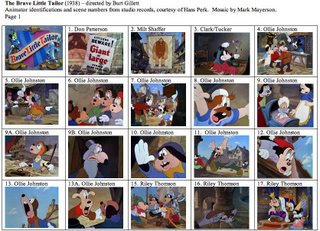
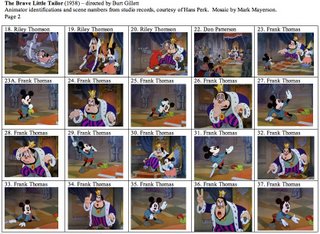
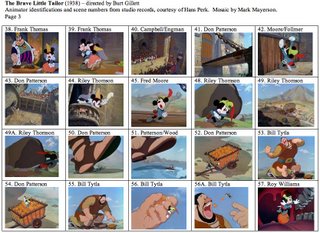
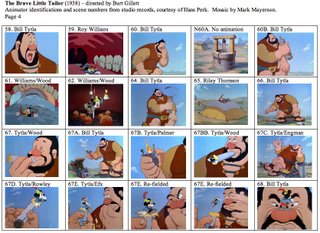
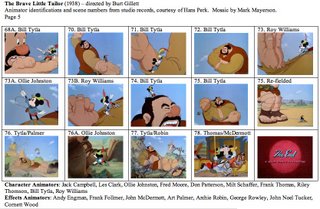 Courtesy of Hans Perk, here's the animator breakdown for The Brave Little Tailor. More on this cartoon later.
Courtesy of Hans Perk, here's the animator breakdown for The Brave Little Tailor. More on this cartoon later.
Thursday, July 06, 2006
The YouTube Purge and a Copyright Rant
Copyrights have become a real sore spot since the invention of the internet. There have been legal challenges to the Sonny Bono copyright act that went all the way to the U.S. Supreme Court, so this isn't just animation fans complaining. The nature of culture in a corporate society is what's being debated. Rights holders are fighting those who feel that the public is being robbed of a common heritage by the extension of copyrights.
When I was younger, the maximum length of copyright in the U.S. was 56 years. If that was still the law, everything before 1950 would be public domain. As it stands, nothing after 1922 is public domain, and so an additional 28 years worth of material is still under the control of copyright holders. Nothing new will be added to the public domain until 2023.
There's a second battlefield and that has to do with how much control rights holders should have over their works. For instance, a musician or record company can't stop their music from being played on the radio. Radio stations pay license fees to performance rights organizations like ASCAP or BMI and then those organizations track how frequently a song is played and split up the license money proportionally.
However, when it comes to film and video, copyright holders can prevent their work from being seen. There is no license fee that a TV station, film distributor or website can pay and then be free to exhibit whatever work they want. The copyright holder has the ability to withhold the work from the public.
Right now, there are huge chunks of animation history that are unavailable legally. NBC-Universal controls the Walter Lantz library. Viacom controls the Terrytoon library. Sony controls the Columbia library, which includes cartoons produced by Charles Mintz, Columbia and UPA. I've got money I'd be happy to spend to acquire these cartoons on DVD. Why won't these companies take my money? And if they won't sell these items, why are they surprised when a black market develops?
Furthermore, even if a cartoon is available on DVD, its presence on the web could be used to draw attention to it. That's called marketing. Or a website could supplement it with new material, such as discussions of the work of the animators, the art direction, etc. In business terms, this is referred to as "value added." Bloggers are increasing the demand for these cartoons by adding information about them for free, and copyright holders are complaining?
We live in a world where businesses control governments through political contributions and lobbying dollars. Individuals haven't got a chance unless they can mobilize public opinion, and copyright is not the kind of bread and butter issue that excites the average voter. The only way that copyright laws will ever change to become fairer is when businesses are fighting other businesses.
YouTube is a rapidly growing website that's trying to dominate the web video business. Their software, allowing people to embed videos in their own blogs or websites, was a stroke of genius for spreading videos and building their own brand. Hollywood is already using YouTube as a farm team for talent and as a marketing tool to promote its own products.
YouTube is in position to argue for a licensing agreement that would guarantee rights holders a percentage of YouTube revenue and allow YouTube's users to post anything they want to the site. In other words, YouTube could function like radio. Unlike radio, where they can only sample how frequently something is played, YouTube can already tell you exactly how many times a clip has been viewed. It leaves the Neilson or Arbitron ratings in the dust.
Rather than limit what users could post, now is the time to open things up. YouTube wants to keep growing. Its users want to share whatever video they feel is worth watching. Rights holders want to get paid. There has to be a way to make everyone happy.
If not, then we're going to be faced with inconsistent enforcement of copyright laws. I guarantee you that in under an hour I could find more than a dozen copyrighted pieces on YouTube. YouTube is leaving itself open to a Napster-like lawsuit where some copyright holder will claim that because YouTube hosts these videos, they're participating in copyright infringement. That's not good business for YouTube or its competitors. A market will be destroyed, fortunes will be lost, piracy will increase and for what? Because we wanted to show a cartoon so we could talk about animation by Rod Scribner, Bob McKimson, Emery Hawkins or Fred Moore?
When will the media wake up and stop alienating the customers who buy their products and want to celebrate them by using examples on the web? When will YouTube wake up and realize its future is with its users and stand up for them against the copyright cops?
Wednesday, July 05, 2006
The Gatekeeper's Credo
(Hitwise has this article stating that YouTube is currently getting 43% of video viewers on the web and that viewership there has increased by 160% in the last three months. Of 500,000 sites tracked by Hitwise, YouTube comes in at number 42. YouTube has yet to announce its revenue sharing formula, but more websites are following up on the idea of paying for content.)
By American network standards, 300,000 people is nothing. If a show had that many viewers, it would be cancelled instantly. Yet because the show is attracting viewers, ABC, NBC and Comedy Central are interested in the pilot again.
What really gets me about the article is the final paragraph, which could serve as the credo of gatekeepers everywhere.
What Mr. Lawrence really wants right now is for so many people to start talking about his comedy pilot now featured on YouTube that some network executive will decide, "Now I can pick this up and I won't look dumb."That sums up the situation nicely. It's not about the project, it's about not letting the gatekeeper look dumb.
Tuesday, July 04, 2006
The Reluctant Dragon Source Material
Furthermore, the knight in the original is St. George. Perhaps the Hays office, the movies' self-censorship body which was closely alligned with the Catholic Church's Legion of Decency, objected to a cartoonified St. George. Or perhaps Disney made the change before they could object.
In any case, St. George in the book is not a poet either, so Disney's story department was not shy about reshaping the material to make a stronger film. They invented enough visual business so that the animators always had something to work with. While the film is fairly dialogue heavy, it doesn't feel that way because the characters are always doing something when they talk. That's a lesson we seem to have forgotten over the years.
Monday, July 03, 2006
Some Business Links
Right now, Revver.com will share 50% of its ad revenue with people who post videos to the site.
I don't know if the subscription model or the advertising model is going to be more successful. Maybe both will thrive. But keep an eye on this. The site that generates the most revenue for its contributors will become the leader in the field.
Meanwhile, the L.A. Times (registration required) has an article that compares the ability of movie executives to pick hits to "an ape throwing darts at a dartboard." It argues that there are so many variables between the time a film gets put into production and the time it gets released that it's impossible to predict the film's popularity with audiences. Winning streaks and losing streaks are more the result of random events than they are executive skill at picking and packaging projects.
Bottom line to both articles: The audience is king. Put your efforts into entertaining them and you've got a better chance than finding an ape to throw your dart.
Sunday, July 02, 2006
Alice Meets the Cheshire Cat
Thanks to Hans Perk's documentation and Thad K.'s editing prowess, here's the sequence where Alice first meets the Cheshire Cat.
It's interesting to see how Don Lusk is relegated to long shots or shots with unimportant dialogue and Marc Davis takes all of the important Alice shots. I can't help but wonder how Lusk, a long time animator at the studio, felt about the shots he was given. Alice is a real drawing challenge. Her proportions have to be rock solid; her facial features are not connected to each other like cartoonier designs, so the animator really has to be accurate. Plus, she has the follow through elements of her hair and dress. Lusk suceeds at all of them but doesn't get the best acting opportunities.
The Animation Podcast with Burny Mattinson mentions that Marc Davis worked by animating every fourth drawing and that his inbetween spacings were always halves or halves of halves. Ken Harris at Warners also worked this way, and it requires the ability to visualize every frame in advance so that the frame that you draw is exactly four drawings ahead of your last key. My hat's off to animators who are capable of that.
Finally, there's John Lounsbery's Cheshire Cat. Lounsbery may be one of the nine old men, but he isn't celebrated like some of the others. He obviously has a talent for comedy and I could easily think that Ward Kimball, who does only the last shot of the cat, was responsible for it all. I think as more animator identifications from the features come out, we're going to be surprised by the skill of the lesser known of the nine. Their relative lack of fame may have more to do with their personalities and studio politics than with their animating abilities. I, for one, would love to know more scenes animated by Lounsbery.
Saturday, July 01, 2006
A Little More on The Reluctant Dragon
Very little of the dialogue refers to bathing, so whether the idea comes from Grahame or Disney, it gives the animators some concrete actions to perform while the dialogue takes care of character exposition. Similarly, when the boy sees the dragon for the second time, none of the dialogue relates to music, but the dragon has physical business with his flute - playing it and using it as a baton - that gives him something to do while interacting with the boy. The birds add an additional visual element to the scene.
The boy's physical business all relates to the book that he carries. He riffles through the pages, stares at pictures and in one of Moore's scenes, ends up leaning on it.
If today wasn't Canada Day, I'd be in a library checking out Grahame's original to see if these physical bits were adapted or invented by the Disney story artists. I'm guessing that if the film was done today, the dialogue would carry these scenes and the the characters would just be gesturing at each other rather than performing specific actions. That would make the animator's job a lot tougher.
If anyone is familiar with the original, please comment. If not, I'll get back to you on this.
